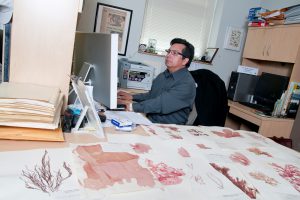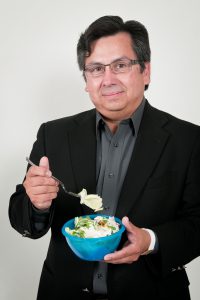By Chris Bryant
Photography by Samantha Hernandez
Odds are, you haven’t thought much about algae today. But, if you brushed your teeth this morning, poured dressing on your salad at lunch, or licked the cold sweetness of ice cream from your lips this afternoon, you’ve had a close encounter with them.
“Their economic importance is tremendous,” says Dr. Juan Lopez-Bautista of algae. “There are many, many, many ways that we interact every day with algae, and we don’t have any idea. The toothpaste is creamy because it contains algae. If you like ice cream or shakes or beer – if we like those textures, it’s because those textures are provided by algae.”
And Lopez, an associate professor of biological sciences at The University of Alabama, is just getting warmed up in listing many of the ways algae touch our daily lives.
“All the dressings for salads are basically derived from red algae,” Lopez says. “The color in our fibers in our clothing is colored because the dye has been fixed to the fiber because of all these chemicals the algae have. The paint that we paint the house with has algae. Many cosmetics use chemicals from algae. Many new drugs that have been studied to fight against viral diseases, including the HIV virus, come from red algae.”

And while our interactions with algae are likely more than we imagined, they don’t begin to match the ways in which Lopez interacts with these members of the Protista kingdom, the largest of which are commonly referred to as seaweeds.
Lopez is part of a four-person team of researchers, from UA, Rutgers University, Ohio University and Bigelow Laboratory for Ocean Sciences, heading a $3 million National Science Foundation effort to develop a comprehensive understanding of red algae and how scientists believe it fits into the world’s evolutionary ladder.
The overall project, known as the Tree of Life, will define the phylogeny – the genetic relationships between organisms and how they are believed to have evolved through history – of the world’s 1.75 million discovered species.
It’s a challenge of a magnitude, Lopez says, akin to putting the first human on the moon.
“The goal,” Lopez says, “is to understand not only these species, but all the ones that are not yet discovered, and how they are related to each other.” Some scientists estimate there may be tens of millions of species not yet discovered.
There are 6,000 different types of red algae, he says.
“That’s just a starting point.”
“One way to understand that relationship between living things in our planet is through DNA analysis. We decipher the DNA sequence of several genes and then we compare those sequences in order to determine which algae are more related to which algae and so forth. We have to do that for every single specimen. You can imagine the amount of data we are going to gather for every single specimen.”
There will be 471 representative specimens analyzed, including about 100 from UA’s own collection. For each one, researchers will generate several thousand bits of DNA information. About eight UA undergraduate and graduate students, one technician and one postdoctoral researcher will be involved in the project.

It’s a process that involves obtaining a sample – dozens arrive at Lopez’s lab weekly courtesy of scientists around the world – extracting the DNA, amplifying the genes in which the scientists are interested and then sequencing those genes.
Understanding what’s gained by gene sequencing can become clearer, Lopez suggests, by thinking of how an alphabet forms the words which comprise languages.
Every molecule of DNA contains the nucleotide bases guanine, adenine, cytosine and thymine. Scientists refer to these bases by their first letter, G, A, C and T.
“The language of life has only four letters – G, A, C and T,” Lopez says. “All living things use the same alphabet and the very same four letters. The words are the genes.”
Using PCR, or polymerase chain reaction, technology and sequence matching, scientists decipher, letter by letter, each word.
“Once we have the words, each particular alga will have the same word spelled in different ways. In some of them, the words will be very similar because they are closely related to each other. The more different the words look, the more they are distantly related.”
In addition to scientists’ natural desire to know more about the world surrounding us, Lopez mentions practical reasons why it’s important to know which species are related.

“Let’s say one alga is used in the production of a chemical that we use in industry. That’s the only one. If we discover which of the other algae are the most closely related to that economically important alga, we know that the other algae should have the same chemical components. Therefore, we can use the others as the source for our technological process.”
Some invasive species of algae have proven toxic and, when found in sufficient quantities outside their place of origin, have led to government shutdown of fisheries, damaging the economy, but protecting the safety of consumers.
“Only some are toxic,” Lopez says. “Others are not. If you make the right call, calling a species toxic might save the life of a local fishery and maybe the life of people, but if you make the wrong call when these are not toxic, then you might be damaging the economy of a region. How can you tell? Well, by DNA analyses you can do this very fast.”
Lopez says he was first drawn to studying algae in college because he enjoyed working with microscopes and plants. Plus, he says, little was, and is, known about them. Although ranging in size from microscopic to several feet in length, they are understudied, he says. This is, at least in part, because they live in ocean environments making them difficult to collect and study.
Lopez says he doesn’t have a favorite type, but when he discovers a new species or lineage of algae – as he’s done several times – he says he thinks he understands the thrills explorers felt hundreds of years ago.
“Imagine the people in the 1830s when Queen Victoria sent all these famous explorers all over the world to bring to Europe, for the first time, things they would have never seen before – a kangaroo – or other things completely unexpected. We’re still doing the same thing – except with algae.
“We are uncovering things that humans have never seen before and, to me, it’s like living in those times when you could explore new worlds, explore new environments, and you have no idea what you are going to find. That’s what attracts me – always the cryptic nature of these algae.”
